Recent Articles
Popular Makes
Body Types
2020 Porsche Taycan Road Test and Review
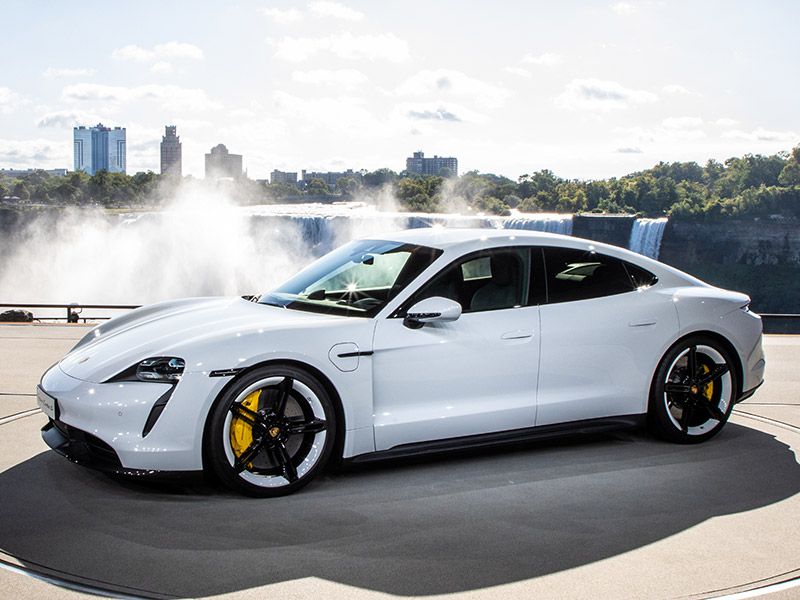
2020 Porsche Taycan ・ Photo by Porsche
The 2020 Porsche Taycan sedan, the company's first all-electric vehicle, gets its name from two terms of Turkish origin. It can be roughly translated as “soul of a spirited young horse,” and Porsche pronounces it tie-kahn, not tay-can. “The name reflects both the source and the future of the brand: the horse on the Porsche crest, the expression of its soul, on its way into a new era of the sports car,” says the automaker that's best known for its sports cars.
How’s that for marketing mumbo jumbo? In plain English, the 2020 Porsche Taycan is the first all-electric four-door sedan from any automaker taking on Elon Musk’s Tesla Model S head-on. Like the rest of the brand’s highly praised lineup, the Taycan brings a unique combination of style, luxury, and extreme performance to the party, and like most Porsches, it comes with a six-figure price tag.
Three Variations to Choose From
All Porsche Taycans are all-wheel drive and powered by two electric motors. Prices start at $105,150, including $1,350 delivery fee. This gets you the Taycan 4S with the base battery pack and 522 horsepower. With the optional larger battery pack, it has 563 horsepower. Tesla doesn’t officially state the power of its vehicles, but the Model S is more affordable than the Porsche, with a base price around $77,000.
Porsche also offers the Taycan Turbo and Turbo S, but don’t let the names fool you — they are not turbocharged like the brand’s gas-powered models such as the 911 Turbo S and Panamera Turbo. Again, every Taycan is all-electric. The Taycan Turbo costs $152,250 and packs 670 horsepower, while the $186,350 Turbo S like our test car is a 750-horsepower monster. This makes it the most powerful sedan on the planet, as well as one of the quickest. Its full-throttle acceleration is so violent it literally snaps back your neck.
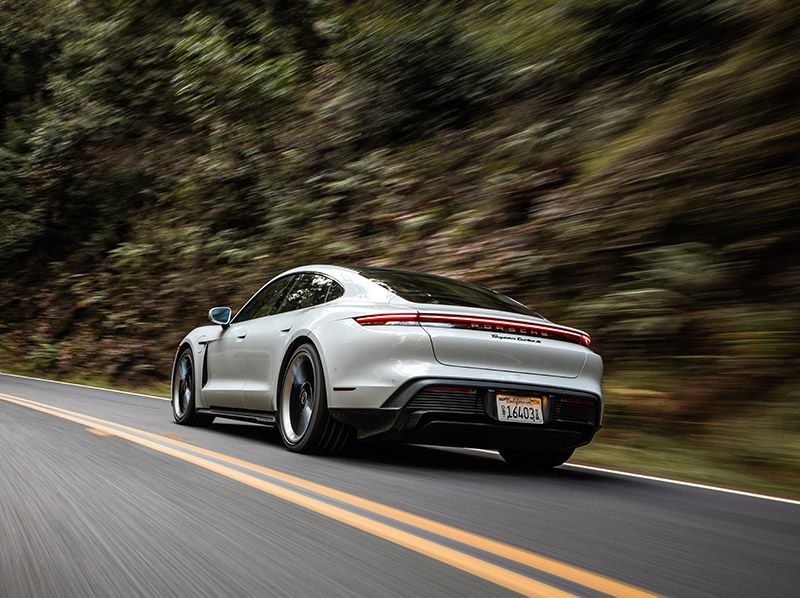
Photo by Porsche
Much Less Range Than Tesla
Before we get to the Taycan’s incredible performance, let's get the subject of its EV range out of the way. Although the Porsche offers enough range for most buyers to drive it daily without fear of being stuck on the side of the road, it is one of the least-efficient electric cars ever. According to the EPA, it has a combined efficiency of just 69 MPGe. The base Tesla Model S Long Range is rated 111 MPGe, while the Jaguar I-PACE is 76 MPGe. Just for comparison, the Hyundai IONIQ EV hatchback, which has a much smaller battery pack, is rated at 136 MPGe.
The government agency also says that on a single charge, the Taycan Turbo has a range of 201 miles, while the Turbo S is good for just 192 miles. The Taycan 4S has a rating of 203 miles. Regardless of the model, these numbers put the Porsche well behind the Tesla Model S, which has range ratings of 326 to 373 miles depending on the trim level.
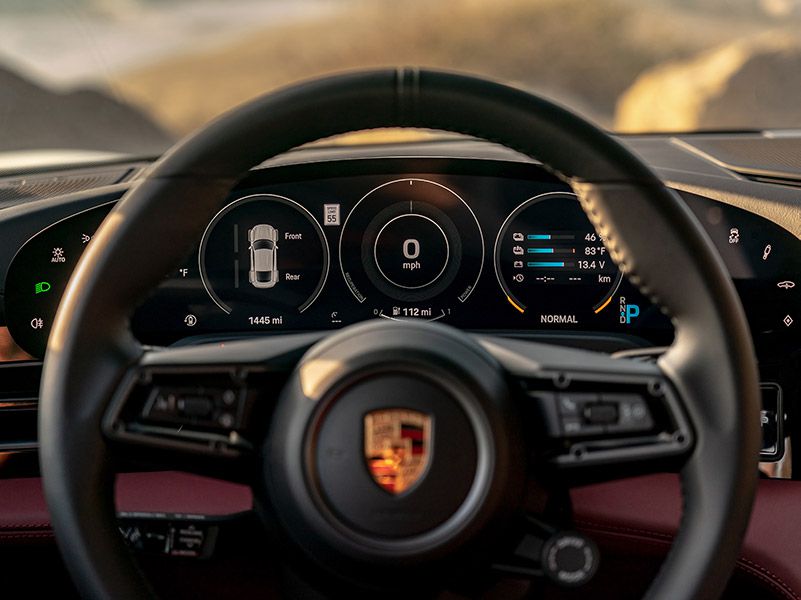
Photo by Porsche
Range and Charging in the Real World
Driving the Taycan Turbo S around Southern California, the most miles we milked from a single charge was about 160 miles. But we weren’t going for maximum range. In fact, we spent quite a bit of time driving the Taycan with a heavy foot in the twisty mountain roads above Santa Barbara. And that kind of driving uses the EV’s charge much more quickly. In normal everyday driving, including highway runs at 75 mph, you should have no problem stretching the Porsche’s energy supply for over 200 miles of driving.
Porsche says the Taycan’s battery pack can be recharged from 5 to 80 percent at a 270-kilowatt charging station in just 22.5 minutes. But only a small number of 800-volt DC fast chargers currently exist. We recharged it twice at more common 400-volt 50-kilowatt DC fast-chargers, swiping our credit card and plugging in with less than 100 miles of range. Filling its batteries took about an hour.
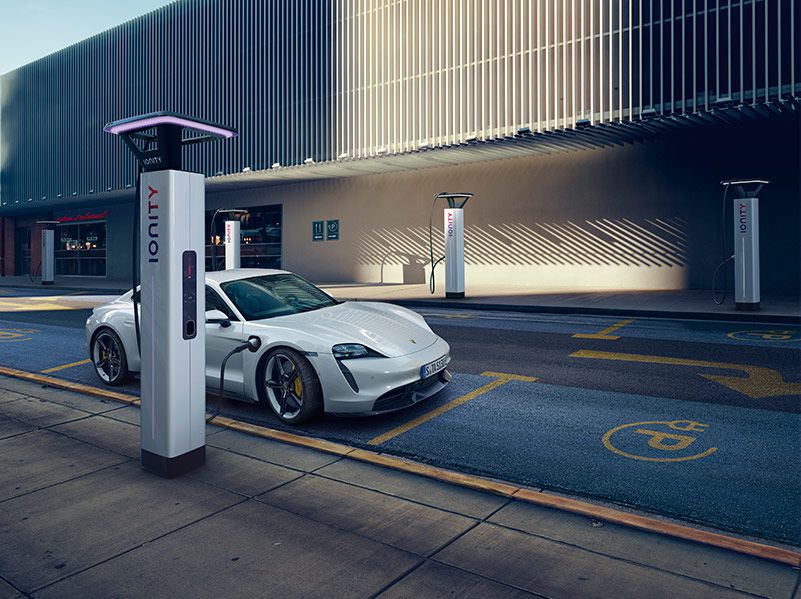
Photo by Porsche
Looks Like Something Special
Porsche’s Panamera, along with the Tesla Model S, helped usher in the age of the luxury four-door liftback, which is now all the rage, and the new Taycan has jumped on that body style bandwagon.
But the Taycan isn’t a hatchback, it just looks like one. Its overall design is similar to the Panamera, but it’s a bit more futuristic, a bit more daring thanks to more radical headlamps. There’s also plenty of 911 in its squatting stance, the curvature of its roofline, and the exaggerations of its voluptuous forms. It’s about the exact same size as the Tesla Model S, but it sits about 2.5 inches lower than its rival, which makes it far sexier. At 114.2 inches, its wheelbase is also about 2 inches shorter than the Tesla’s and the Panamera’s, which give it greater visual intensity at the expense of some elegance and rear seat space. The Turbo S wears massive 21-inch wheels and tires, and with options, our test car cost $205,180. It looked every bit of it.

Photo by Porsche
Smaller Inside Than Its Rivals
The Taycan’s rear passengers get a couple of air conditioning vents and a rear console, which offers a couple of cupholders. That’s right, like the Panamera Sport Turismo, this Porsche is a four-seater. The Tesla Model S seats five (its optional third row is no longer available), and it has more rear head and legroom than the Taycan. Overall, the Taycan is spacious enough to function well as a family car, but only if your family doesn’t include varsity basketball players.
There’s plenty of cargo volume with 12.9 cubic feet of trunk space, and its rear seats are split 60/40 and easily fold flat to carry longer items. Although the Panamera is a hatchback, it doesn’t offer much more luggage space. But the Tesla Models S certainly does — nearly twice as much as the Taycan.
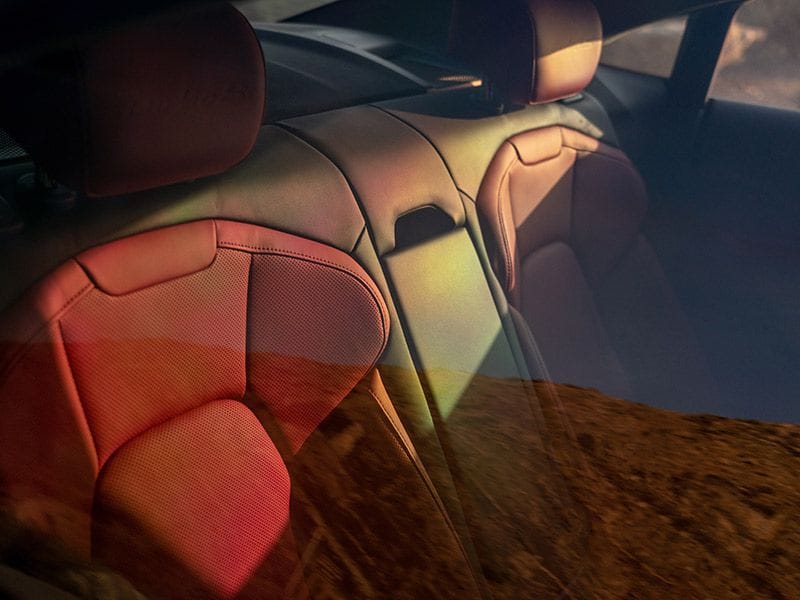
Photo by Porsche
Comfortable, Sporty Interior
You sit low in the Taycan, which only adds to the sedan’s sports car feel. Visibility is excellent, however, and the driver’s seat is height-adjustable so drivers of any height should be able to get comfortable. The EV’s dash and wide console are similar to the layouts used in the brand’s sports cars and SUVs, and the overall design works well. It feels upscale but exceedingly modern. Build quality is off the charts, and the curved digital instrument cluster is sci-fi cool.
The Taycan’s climate controls, infotainment system, and many other features, including its seat heaters, are controlled with a second large touchscreen on its console. It functions well enough, but will certainly take some getting used to. The console also features two cupholders and some storage. Keeping with tradition, Porsche has placed the sedan’s start button to the left of its steering wheel. Its shifter, however, is a break from the norm. It’s a stubby little thing on the dash.
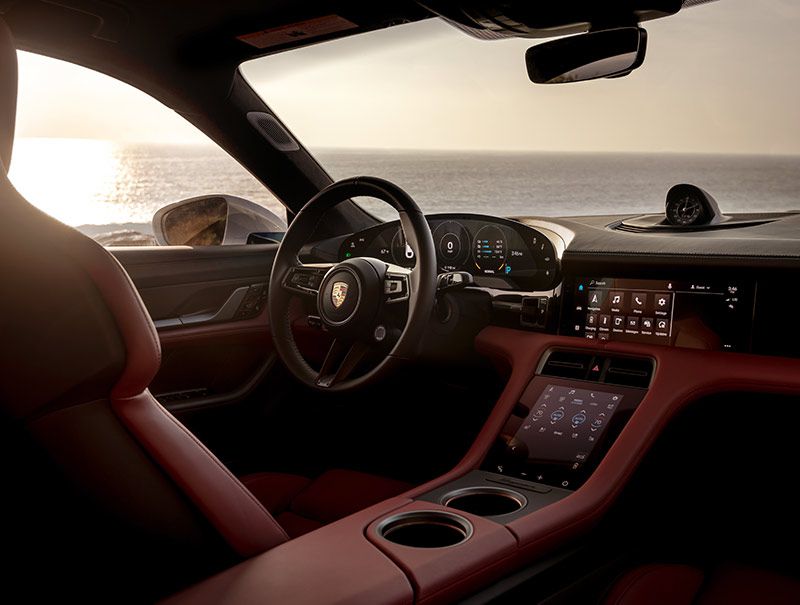
Photo by Porsche
Explosively Quick
This is one of the quickest cars in the world. Porsche says the Taycan 4S can burst to 60 mph in just 3.8 seconds and the Turbo can do it in 3.0 seconds. The acceleration of the Turbo S, however, takes your breath away. It doesn’t only reach 60 mph in 2.6 seconds, Porsche says, “With a standing start of 1.2g, it accelerates faster than the force of gravity for the first few yards — making it faster than a skydiver in free fall.” Its top speed is 161 mph.
The Tesla Model S Performance is just as quick, but the Porsche, with its unique two-speed transmission, starts pulling away hard as the two cars pass 100 mph. By 150 mph, the Taycan is several seconds ahead. And the Taycan’s incredible speed is only half the story. Its powertrain is also exceedingly smooth and refined, and like all EVs, it goes about its business very quietly, with just a whir from its electric motors. Porsche does give the EV an artificial engine-style groan so pedestrians can hear it coming.
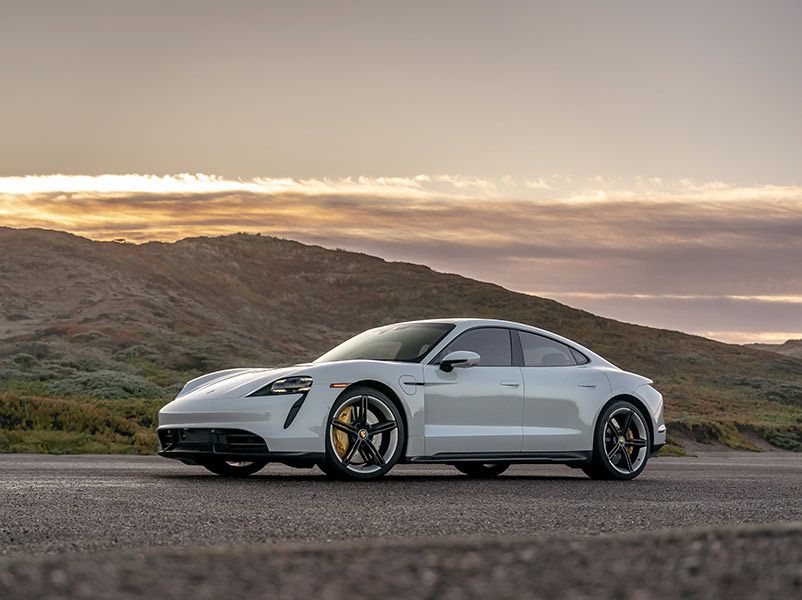
Photo by Porsche
Fast, Fun, and Refined
Despite its over 5,000 lbs of heft, the Taycan also drives like a real Porsche, with sports car agility along with one of the smoothest rides in this class. Our Turbo S test vehicle delivered an inspired combination of luxury and performance. The sedan is extremely smooth, comfortable, and quiet. It feels solid and substantial and rides beautifully. Despite its 21-inch wheels and tires, its adjustable air suspension perfectly isolates its passengers from potholes, surface changes, and other road irregularities.
Most cars that ride this well float over the road and around corners. They lose their ability to be fun and sporty. Not the one. This is still a Porsche. And the Taycan is a true sports sedan. It’s engaging. And it corners like a car half its size and weight, especially in Sport Plus Mode, which increases throttle response and firms up its suspension. The Taycan lets you know you’re approaching its limits with a touch of understeer, and its steering feel is properly PorscheThe stopping power of our test car's massive carbon ceramic brakes also lives up to the brand’s legacy
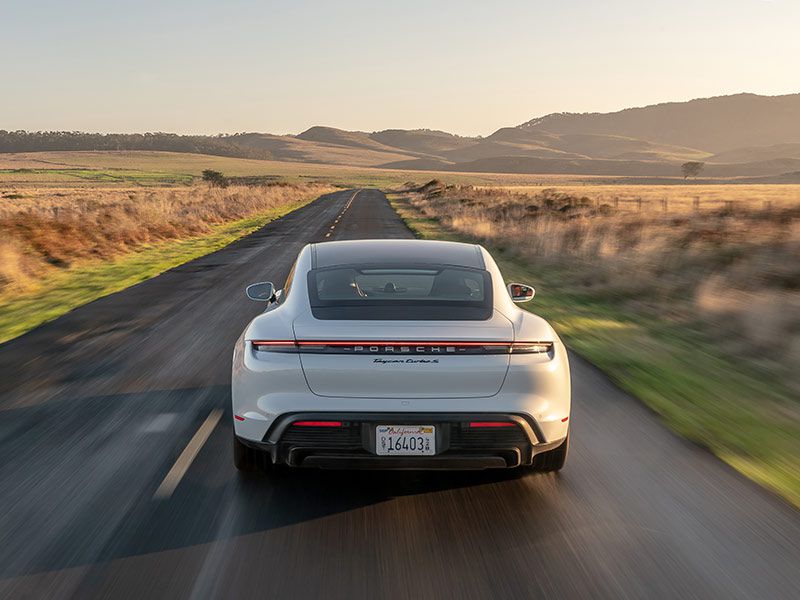
Photo by Porsche
Final Thoughts
A neighbor told us he read somewhere that the Taycan is really fast, but to protect its electric drivetrain from heat, its peak power can only last 2.5 seconds at a time. After that short burst, its maximum power is reduced. This is true, but it’s not a problem in the real world. The reduction of power is not significant enough to be felt. Trust us, you’ll never think the Taycan needs more power.
Although the Tesla Model S remains exceedingly impressive, and it’s a far better value than the Porsche, the new Taycan brings more style and more athletic handling to the fight. And its owners' club is sure to be more exclusive. If you’re looking for an all-electric luxury sedan, the 2020 Porsche Taycan is an extremely desirable choice.
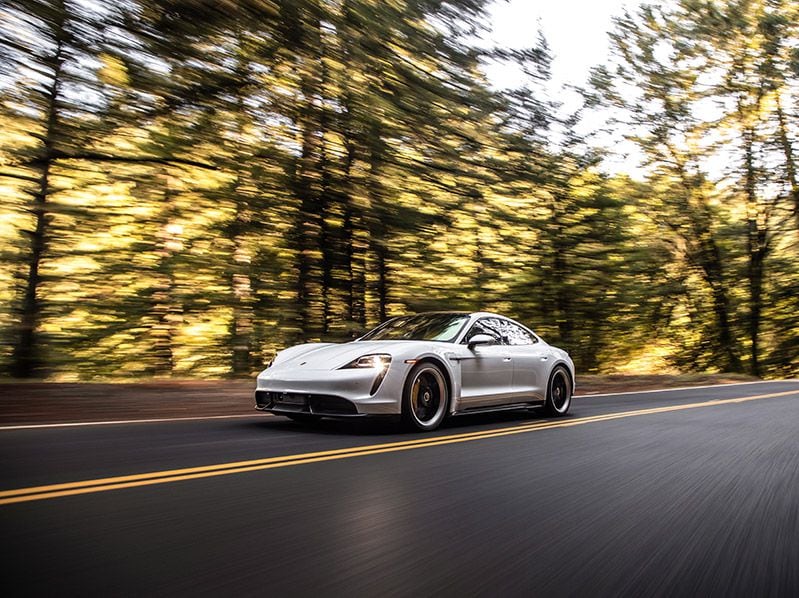
Photo by Porsche